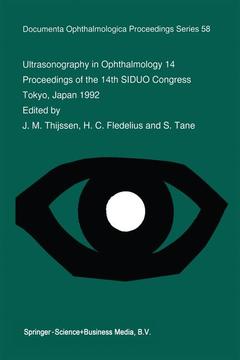Description
Ultrasonography in Ophthalmology 14, Softcover reprint of the original 1st ed. 1995
Proceedings of the 14th SIDUO Congress, Tokyo, Japan 1992
Documenta Ophthalmologica Proceedings Series, Vol. 58
Coordinators: Thijssen J.M., Fledelius H.C., Tane S.
Language: English
Subject for Ultrasonography in Ophthalmology 14:
Keywords
diagnosis; ophthalmology; sonography; ultrasonography; ultrasound
Publication date: 10-2012
268 p. · 16x24 cm · Paperback
268 p. · 16x24 cm · Paperback
Description
/li>Contents
/li>
This volume presents a selection of the papers presented at the 14th SIDUO Congress, Tokyo, Japan, 1992. The papers are grouped into the following subjects: instrumentation and techniques, biometric ultrasound, diagnosis of intraocular disease, and diagnosis of orbital and periorbital disease.
One: Instrumentation and Techniques.- 1.1. Processing and Analysis of Echograms: A Review 1.- 1.2. Acoustic Tissue Typing (ATT) by Sonocare (Sonovision, Computerized B-Scan, STT100). Our Experience and Results.- 1.3. Processings for Echographic 3D Display in Ophthalmology: A Survey.- 1.4. 3D (Three-Dimensional) Reconstruction of Video-Recorded 19 Ultrasound Images: Up-Dates.- 1.5. Comparison of Ultrsonography, Computed Tomography and 25 Magnetic Resonance Imaging in the Diagnosis of Orbital.- 1.6. Imaging of the Anterior Segment of the Eye by a High Frequency Ultrasonograph.- 1.7. Annular Array Probe for Ocular Tissues Imaging.- Two: Biometric Ultrasound.- 2.1. Eye Size, Refraction and Ocular Morbidity: An Ultrasound Oculometry Review.- 2.2. Echobiometric and Refractive Evaluation in Pre-Term and Full-Term Newborns.- 2.3. The Growth of the Eye in Paediatric Aphakia: Reports of Echobiometry During the First Year of Life.- 2.4. Ophthalmic Ultrasound as used in Taiwan Republic of China.- 2.5. Axial Length Measurement in Silicone-Oil-Treated Eyes.- 2.6. The Ratio Axial Eye Length/Corneal Curvature Radius and IOL Calculation.- 2.7. Intraindividual Differences of Calculated Lens Power in Patients with Different Degrees of Anisometropia and Clear Lens.- 2.8. Changes in the Thickness of the Lens During Imagination: An Echographic Study.- 2.9. A Biomechanical Model for the Mechanism of Accommodation.- 2.10. Biometry with Mini-A Scan Instrument.- 2.11. Accuracy of the Modified IOL Power Formulas for Emmetropia.- 2.12. Ultrasonographic Evaluation of Axial Length Changes Following Scleral Buckling Surgery.- Three: Diagnosis of Intraocular Diseases.- 3.1. Intraocular Inflammation and Combined Annular Choroidal and Retinal Detachment.- 3.2. Echographic Study of Severe Vogt-Koyanagi-Harada Syndrome with Bullous Retinal Detachment.- 3.3. Ultrasonographic Features of Various Ocular Disorders Using Experimental Rabbit Models.- 3.4. Investigation on the Accuracy of Measured Parameters for the Diagnosis of Cataract by Ultrasonic Tissue Characterization.- 3.5. Staging of ROP by Means of Computerized Echography.- 3.6. The Analysis of Radiofrequency Ultrasonic Echosignals for Intraocular Tumors.- 3.7. Atypical Retinoblastomas.- 3.8. Ultrasonic Diagnosis in Breast Carcinoma Metastatic to the Choroid. Clinical Experience from 20 Cases.- 3.9. Analysis of Ocular Circulatory Kinetics in Glaucoma by the Ultrasonic Doppler Method.- 3.10. High Resolution B-Mode Evaluation of Macular Holes.- 3.11. Contact B-Scan Ultrasound Evaluation of the Vitreoretinal Interface in Emmetropic and Normal Eyes.- 3.12. Dynamic Interaction of Vitreoretinal Adhesion.- 3.13. Echographic Characteristics of Perfluorodecalin: A Case Report.- 3.14. The Diagnosis and Management of Intraocular Inflammation with Standardized Echography, with Emphasis on Macular Thickness.- 3.15. Posterior Scleritis-Monitoring of Systemic Steroid Treatment with Standardized Echography: A Case Report.- 3.16. Ultrasonographic Analysis of Glaucomatous Eyes.- Four: Diagnosis of Orbital-and Periorbital Diseases.- 4.1. Standardized Optic Nerve Echography in Patients with Empty Sella.- 4.2. Echographic Follow-Up of Orbital Rhabdomyosarcoma in a Child.- 4.3. Findings in Standardized Echography for Orbital Hemangiopericytoma.- 4.4. Respective Roles of Echography, CT Scanner and MR Imaging in the Diagnosis of Orbital Space Occupying Lesions.- 4.5. Diagnosis of Carotid-Cavernous Sinus Fistula Using Ultrasound, Color Doppler Imaging, CT-Scan and Digital Subtraction Angiography.- 4.6. Color Doppler Imaging of Orbital BloodFlow in Dysthyroid Ophthalmopathy.- 4.7. New Echographic Findings in Orbital Diseases.- 4.8. Standardized A-Scan Evaluation of the Ophthalmic Artery-Optic Nerve Sheath Complex.- 4.9. Ultrasonographic Measurements of Extraocular Muscle Thickness in Normal Eyes and Eyes with Orbital Disorders Causing Extraocular Muscle Thickening.- 4.10. The Merit of Electronic Linear Scan Ultrasonic Tomography of the Orbit.- 4.11. Orbital Veins at the B-Scan Image.- 4.12. Orbital Teratoma: Presentation of a Case.
© 2024 LAVOISIER S.A.S.




